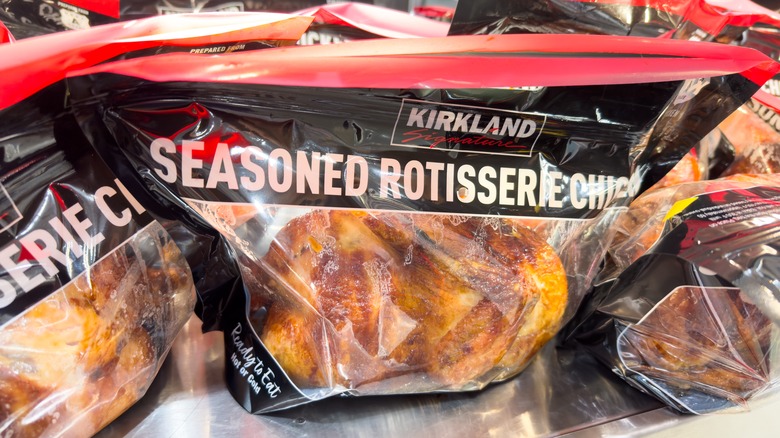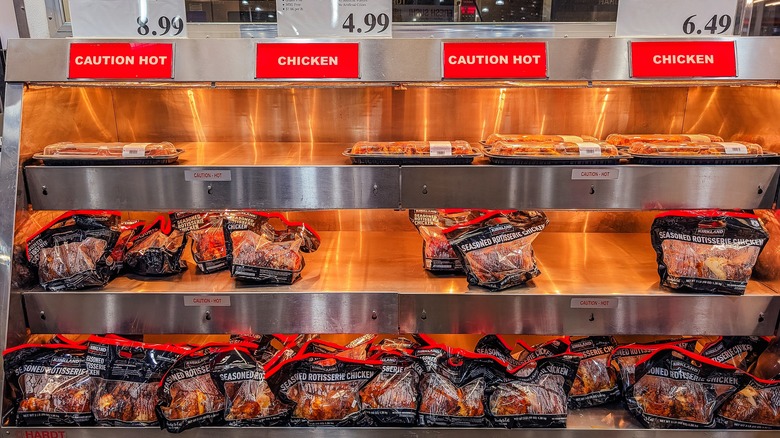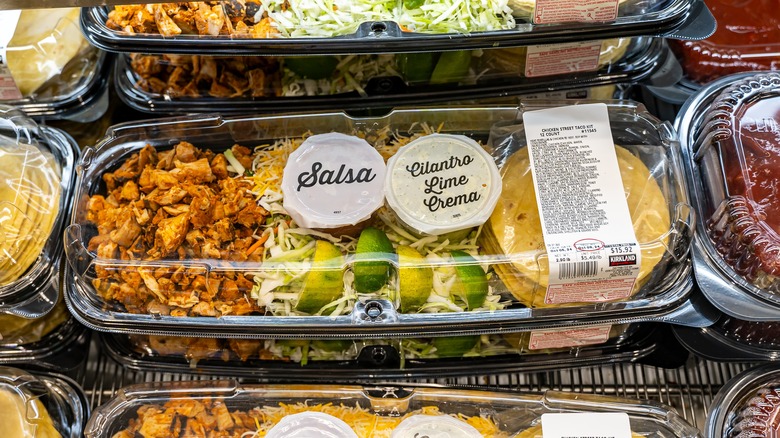How Much Money Costco Really Wastes On Leftover Rotisserie Chicken
Waste not, want not: it's a philosophy that has served generations of foodies well, including those who shop at Costco. Repurposing leftovers into other meals is one of many tried and true tricks of frugal people. As long as there is still meat on the bone, clever home chefs can get a stew going, so to speak — and so can the staff at Costco's deli counter.
Costco's infamously (and mysteriously) cheap rotisserie chicken is a cart cornerstone for shoppers on a budget. But while the $4.99 roast bird might be a win for shoppers looking for tasty ways to save on groceries, the cheap chicken is a loss leader for Costco. This means the chicken stays at a mouth-wateringly low price point to get customers into the store and stocking up on other, profitable items snagged through their paid Costco membership perks.
However, the company trims some of its poultry-related losses by incorporating unsold rotisserie chicken meat into other offerings, with all the trimmings. This technique likely ends up recouping some of Costco's considerable chicken spend, as well as providing additional ways for Costco members to save.
Costco's chicken spend
Costco might serve up finger-lickin' good chicken savings, but at what cost? No hard and fast loss data exists on record, but a look at the company's general attitude towards chicken production and loss-leader pricing might indicate how much Costco has invested in keeping cheap chicken so cheap.
Per data analysis from business and tech publication, The Hustle, Costco should be pricing its chickens somewhere north of $8 per bird, to account for rising costs and inflation. However, Costco has largely kept its chicken prices the same for over a decade. This dogged commitment to low chicken pricing is also reflected in the $1.50 hot dog special, which former Costco CEO Jim Sinegal once famously threatened pain of death over if prices ever went up.
Rotisserie chickens have been a loss-leading lure since their introduction to grocery aisles in the 1990s. They made their Costco debut in 1994, and hit their current $4.99 price point in 2009. In 2015, Costco CFO Richard Galanti also held the line on pricing, telling analysts on a call (via Time): "When others were raising their chicken prices from $4.99 to $5.99, we were willing to eat, if you will, $30 to $40 million a year in gross margin by keeping it at $4.99." By 2023, Costco spent $1 billion or so on its own Nebraska-based chicken plant, which produces 2 million chickens weekly, meeting about one-third of the company's chicken needs (via Forbes.) This investment makes clear that whatever Costco might lose on its cheap chicken, the company is counting on this value-priced product to continue to make overall year-over-year gains.
More winner, winner chicken dinners
In 2023 alone, Costco reported sales of 137 million chickens. In 2024, gross profits sat at $32.795 billion. Keep these mind-clucking numbers in mind as you learn about the Costco chicken stocking and repurposing process. Costco keeps a strict two-hour turnover on rotisserie chickens sitting under heat lamps, in order to amply avoid temperature-related food safety issues and to ensure overall quality control. Every time a bell rings, an angel might get their wings — but every time a Costco bell chimes, it's chicken-changing time.
When the time is up, any remaining chickens are pulled from their warming stations and processed for other products, while freshly-roasted rotisserie chickens are moved out for purchase in the warming area. Unsold but in-temp chicken is processed into ready-to-assemble chicken taco kits, take-and-bake chicken pot pies, chicken alfredo pasta packs, tubs of chicken salad, and used in other salads, soups, chilis, wraps, and prepared food offerings. These items are packaged for sale and chilled appropriately.
While it's practically impossible to beat the price point of the whole $4.99 rotisserie chicken from Costco, snagging low-priced by volume soup and pasta dishes can certainly add to further savings. Re-portioning and freezing smaller servings of these prepared chicken dishes at home can seriously stretch some dollars — and if you have at least $7 left over, you might even be tempted to pick up another treat that pairs well with dinner, like a hilariously-named and inexpensive beef product, ice cream, or some of Costco's inexpensive but extensive selection of wines.


